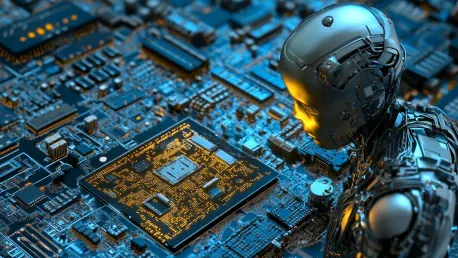AMD, known for its innovative technology, has made significant strides in AI hardware tailored for data center applications. This cutting-edge development promises to reshape how data centers operate, enhancing their efficiency and performance in handling demanding AI workloads. By introducing a series of advanced AI hardware products, AMD is not just keeping pace with the industry but is poised to take a leading role. This article delves into AMD’s recent advancements, exploring the implications and benefits for the future of data centers, and highlighting the strategic decisions the company is making to secure its position in this rapidly evolving space.
Introduction of Instinct MI325X Accelerators
AMD’s latest line of accelerators, the Instinct MI325X, marks a major milestone in AI hardware. Built on AMD’s cutting-edge CDNA 3 architecture, these accelerators are designed to deliver exceptionally high performance and efficiency. One of the standout features of the MI325X is its 256GB of High Bandwidth Memory 3E (HBM3E), which provides an astonishing 6.0 terabytes per second of memory bandwidth. This immense bandwidth dramatically enhances the data handling capabilities of the accelerator, making it perfect for the computation-heavy tasks typical in modern AI applications.
The MI325X accelerators are specifically designed to manage intricate AI tasks such as training and inference for large language models. These accelerators boast up to 1.3 times greater peak theoretical FP16 and FP8 compute performance compared to previous generations, translating to significant improvements in processing speeds and efficiency. This enhanced capability ensures that data centers adopting the MI325X accelerators will experience substantial boosts in their ability to handle complex and voluminous AI workloads with greater speed and efficiency.
Set to begin production in Q4 of 2024, the introduction of the MI325X highlights AMD’s commitment to pushing the boundaries of AI hardware. By providing cutting-edge solutions that outperform previous models, AMD aims to offer a competitive edge over its rivals. The introduction of these accelerators positions AMD as a formidable player in the AI hardware market, offering solutions that promise to meet the growing demands of data centers worldwide.
Future-Proofing with Next-Generation Instinct MI350 Series
In a forward-thinking move, AMD has also previewed the next-generation Instinct MI350 series, which is set for release in the second half of 2025. These upcoming accelerators are built on the forthcoming CDNA 4 architecture and promise a staggering 35-fold improvement in inference performance over current models. This significant leap in capability positions the MI350 series as industry leaders upon their release, redefining standards for AI inference and ensuring that data centers employing these accelerators will be at the forefront of technology.
The MI350 series is expected to deliver unprecedented performance, making them ideal for data centers that handle increasingly complex and high-volume AI tasks. By future-proofing their technology, AMD ensures that they remain a step ahead in the AI hardware innovation race. These future-ready technologies are not just about meeting the current demands but also about anticipating and addressing the evolving needs of the market, guaranteeing that data centers equipped with MI350 accelerators will be well-prepared for future AI developments.
Moreover, AMD’s strategic release timing for the MI350 series aligns with market trends, reflecting the company’s proactive planning and understanding of industry needs. By positioning themselves to provide next-generation solutions that coincide with the market’s demands, AMD showcases their commitment to being at the cutting edge of AI hardware technology. Data centers adopting these next-gen accelerators will not only benefit from current advancements but will also be prepared to handle the increasing demands of future AI workloads with ease.
Expanded Networking Solutions
AMD’s innovations extend beyond just accelerators, encompassing robust networking solutions that enhance data center infrastructure and performance. A prime example of this is the Pensando Salina Data Processing Unit (DPU), designed to support the front end of AI networks with an impressive 400 gigabit per second throughput. This capacity translates to twice the performance, bandwidth, and scale compared to its predecessor, significantly enhancing data centers’ ability to manage large-scale AI deployments efficiently.
The increased throughput and bandwidth of the Pensando Salina DPU are critical for modern AI applications, which require rapid data processing and seamless communication between different components of the data center infrastructure. By providing such high-performance networking solutions, AMD ensures that their AI hardware operates at optimal levels, maximizing efficiency and performance across the board.
Complementing the Salina DPU is the Pensando Pollara 400 Network Interface Card (NIC), touted as the industry’s first Ultra Ethernet Consortium (UEC) ready AI NIC. This unique NIC optimizes accelerator-to-accelerator communication within AI clusters, a feature critical for seamless and rapid data processing. Optimized communication is essential for ensuring that data centers can handle the demanding workloads of modern AI applications without bottlenecks or delays.
Both the Pensando Salina DPU and Pollara 400 NIC are currently being sampled, with availability expected in the first half of 2025. These advanced networking solutions underscore AMD’s holistic approach to data center infrastructure, ensuring that all components are finely tuned for peak performance. By integrating these networking solutions with their high-performance accelerators, AMD provides a comprehensive package that meets the diverse needs of modern data centers.
Software Enhancements for Improved Performance
In tandem with its impressive hardware developments, AMD has also invested significantly in software to maximize the potential of their AI hardware. At the core of these software enhancements is the ROCm open software stack, which supports key compute engines in popular AI frameworks and libraries like PyTorch and Hugging Face. This robust software support ensures that data centers can fully leverage AMD’s advanced hardware capabilities.
ROCm version 6.2 introduces several novel AI features, including the FP8 datatype and Flash Attention 3, which offer substantial performance gains. This new version has demonstrated up to a 2.4 times improvement in inference performance and a 1.8 times improvement in training for various large language models compared to ROCm 6.0. These performance boosts are critical for data centers that need to handle increasingly complex and demanding AI workloads with efficiency and speed.
The software enhancements provided by ROCm ensure that data centers can integrate and optimize AMD’s advanced hardware with ease, resulting in seamless performance and improved productivity. The combination of robust hardware and comprehensive software support positions AMD as a leader in delivering full-stack AI solutions that meet the growing demands of the industry.
By investing in both hardware and software, AMD showcases their commitment to providing holistic solutions that address all aspects of AI deployment. This strategic approach ensures that data centers can fully utilize AMD’s technologies, achieving optimal performance and efficiency in their AI operations.
Convergence of Hardware and Software
AMD, celebrated for its pioneering technology, has made impressive advancements in AI hardware designed specifically for data center applications. This state-of-the-art innovation is set to revolutionize data center operations, significantly boosting their efficiency and performance in managing demanding AI tasks. By unveiling a series of sophisticated AI hardware products, AMD is not merely keeping up with the industry; it is positioning itself as a frontrunner. This article examines AMD’s latest breakthroughs, shedding light on the potential future benefits for data centers. AMD’s strategic initiatives are also highlighted, showcasing the company’s efforts to cement its leadership in this fast-changing landscape. These advancements underscore AMD’s commitment to driving progress and setting new benchmarks in AI technology for data centers, ensuring they remain at the cutting edge of digital transformation. As AMD continues to innovate, its influence on the industry grows, making it a critical player in shaping the future of data center technology and AI capabilities.









